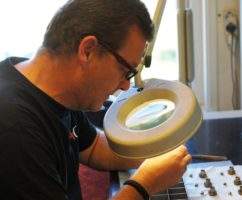DAO Aviation A/S Aircraft Maintenance, TPE331 MRO, Component Sales and Avionics


As a full service provider for engines, airframes and avionics, DAO is an excellent match for many small to medium size operators.
The combination of global engine components and spare part services as well as the more European-focused airframe support allows DAO to provide a worldwide service.
Part 145 Maintenance for fixed wing aircraft
DAO Aviation provides EASA Part 145 base and line maintenance services in accordance with the manufacturer’s specifications. DAO Aviation has experienced staff that possess part 66 licenses for inspecting a range of turbine and piston-powered aircraft from Cessna 172’s to Challenger 850’s.
Amongst other services we can facilitate airframe minor and major inspections, structural repairs and modifications as well as aircraft engine replacements. Our services also include landing gear repair, overhauls and dynamic propeller balancing.
We pride ourselves on having a strong, experienced team ready to assist with aircraft on the ground (AOG) field services with the urgency necessary to limit the economic impact to the customer.
Our team is always ready to travel worldwide to ensure our customers keep on flying. DAO Aviation is authorised as a RUAG service centre on the Dornier 228 Series.
TPE331 Honeywell engine services
DAO Aviation has more than 30 years of experience with Honeywell TPE331 engines, and is today one of the largest TPE331 engine shops worldwide. As a Honeywell Heavy Authorised Service Centre, we have the opportunity to offer a large selection of TPE331 services and support which covers the complete TPE331 engine series from TPE331-1 up to TPE331-14.
Our technicians are expertly skilled and licensed to perform the following services including but not limited to hot section inspection (HSI), gearbox inspection (GBI), compressor inspection, complete engine overhaul (CAM), foreign object damage and TBO extension to name a few. Our Honeywell rental engine bank consists of all engine types and is available for all engine events, scheduled, unscheduled and also AOG situations.
Overnight component parts sales
With more than 30,000 line items in stock, all from engine manufacturers, approved dealers or overhaul facilities, and with EASA FORM 1 or FAA FORM 8130-3 certificates, DAO serves its worldwide customer base with overnight carriers. The company can provide:
- Fuel nozzles
- Starter generators
- Fuel pumps
- All engine accessories
- Hydraulics
DAO Avionics service centre
DAO Avionics is a fully equipped part 145 avionics service centre for fixed wing aircraft. The avionics team has the following ratings: C 2 Auto Flight, C 3 Comms and Nav, C 5 Electrical Power, and C 13 Instruments. As a member of Aircraft Electronics Association (AEA), we keep on top of the ever changing avionic market.
Our certified staff have the experience to carry out repairs, conversions, modifications, or a complete overhaul of avionics equipment. We can perform ‘pre-purchase’ inspections of avionic units or complete avionic installations before a possible aircraft purchase, saving the customer time and money when importing an aircraft.
There is also several market leading avionic dealers enabling us to source the customers desired product quickly and cost-effectively. We are certified with the following dealerships to name a few:
- Rockwell Collins
- Garmin
- Avidyne
- Universal Avionics
- Honeywell
- Aspen Avionics
Design Organisation Approval (DOA)
DAO Aviation holds EASA Part 21J design organisation approval (DOA). This design organisation is the customers entry point for any request regarding design and certification of any aircraft change or structural repair.
The innovative, dedicated and highly experienced design team will assist in bringing customers needs into safe and reliable solutions, all the way from starting out as an idea, through planning, certification and implementation on your airplane, for example:
- Avionic upgrades
- Antenna and sensor installation
- Aircraft import, existing modification certification
- Flight inspection system installation
- In flight entertainment systems (IFE)
- Satellite communication and tracking systems (SatCom)
- Ambulance and EMS / HEMS modification
- Camera installation
- Research and development prototype installations
- VIP configuration.
- Continuing Airworthiness Management Organisation (CAMO)
The DAO Continuing Airworthiness Management Organisation is a standalone approval referred to EU Regulation 2042 / 2003, Part-M Section A Subpart G. As an added value to our customers we also provide a CAMO service which is ready to help aircraft and helicopter owners / operators comply with the new EASA requirements.
The CAMO will have the privilege to issue recommendations or airworthiness review certificates after an airworthiness review as specified in part-M.A.710.
This means that the owner / operator will not be burdened with the daily airworthiness management workload but can concentrate on flight concerns, and enjoy the pleasures of flying.
DAO Aviation strives to keep our customers flying. Should you like to get in touch with DAO Aviation please use the form below to send us your enquiry, or alternatively contact us via the contact details.
DAO certifications
DAO is fully EASA Part-145 certified (cert. no. DK.145.0020) for a range of aircraft types, components, avionics equipment, engines and accessories.
Our status as a Honeywell-Authorized Heavy Service Centre for the TPE331 engine and RUAG Authorised Service Centre for the Dornier 228 Aircraft is an essential anchoring point for us to ensure ‘we keep our customers flying’.
Products and Services
Video
White Papers
Press Release
DAO Aviation, a provider of aircraft services for business and corporate aircraft, has become a designated Honeywell-authorized TPE331 major level service center for the maintenance and service of the TPE331-1 to TPE331-14 series of turboprop engines. Jimmy Andersen, president of DAO A
Read moreRegional Offices
Copenhagen Airport, Roskilde
Hangarvej H1
4000 Roskilde
Denmark

















